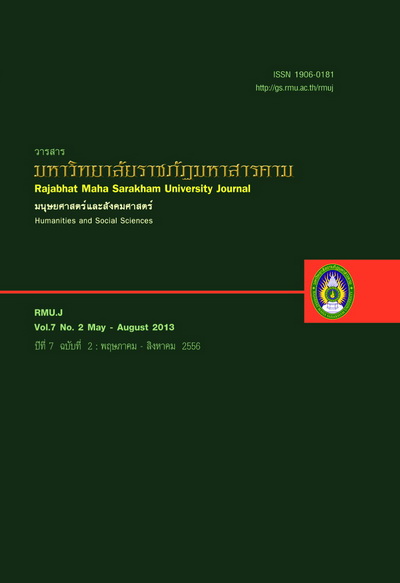ผลการเรียนด้วยบทเรียนบนเว็บแบบผสมผสาน 2 รูปแบบ เรื่อง การสื่อสารข้อมูลและเครือข่าย คอมพิวเตอร์ ที่มีต่อผลสัมฤทธิ์ทางการเรียน การคิดวิเคราะห์ และความคงทนในการเรียนรู้ของ นักเรียนชั้นมัธยมศึกษาปีที่ 2 ที่มีแรงจูงใจใฝ่สัมฤทธิ์ต่างกัน
Main Article Content
Abstract
บทคัดย่อ
การวิจัยครั้งนี้มีวัตถุประสงค์ ประการแรก เพื่อพัฒนาบทเรียนบนเว็บแบบผสมผสาน 2 รูปแบบ เรื่อง การสื่อสารข้อมูลและ เครือข่ายคอมพิวเตอร์ ประการที่สอง เพื่อเปรียบเทียบผลสัมฤทธิ์ทางการเรียน การคิดวิเคราะห์ และความคงทนในการเรียนรู้ ของ นักเรียนที่มีแรงจูงใจใฝ่สัมฤทธิ์ต่างกันและเรียนด้วยบทเรียนบนเว็บแบบผสมผสานรูปแบบต่างกัน และประการที่สาม ศึกษาความพึง พอใจของนักเรียนต่อการเรียนด้วยบทเรียนบนเว็บแบบผสมผสานทั้ง 2 รูปแบบ กลุ่มตัวอย่างเป็นนักเรียนชั้นมัธยมศึกษาปีที่ 2 ภาค เรียนที่ 2 ปีการศึกษา 2554 โรงเรียนชุมชนหนองบัวน้อยโนนชาติหนองเห็นวิทยา จำนวน 34 คน และโรงเรียนบ้านโนนป่าหว้านเชียง ฮาย จำนวน 20 คน ซึ่งได้มาจากการสุ่มแบบกลุ่ม (Cluster Random Sampling) โดยการจับสลาก เครื่องมือที่ใช้ในการวิจัยครั้งนี้ ได้แก่ 1) บทเรียนบนเว็บแบบผสมผสาน แบบ 70 : 30 และแบบ 30 : 70 2) แบบวัดผลสัมฤทธิ์ทางการเรียน จำนวน 30 ข้อ และ 3) แบบทดสอบวัดความสามารถในการคิดวิเคราะห์ จำนวน 20 ข้อ สถิติที่ใช้ในการวิเคราะห์ข้อมูล ได้แก่ ร้อยละ ค่าเฉลี่ย ส่วนเบี่ยงเบน มาตรฐาน Dependent Samples t-test, F-test (Two-way MANCOVA, Two-way ANCOVA และ Two-way ANOVA) ผล การวิจัย พบว่า
1. บทเรียนบนเว็บแบบผสมผสาน แบบ 70 : 30 และแบบ 30 : 70 มีค่าประสิทธิภาพเท่ากับ 81.30/80.88 และ 81.00/80.33 ตามลำดับ และ มีค่าดัชนีประสิทธิผลเท่ากับ 0.7147 และ 0.5593 ตามลำดับ
2. นักเรียนโดยรวมและนักเรียนที่มีแรงจูงใจใฝ่สัมฤทธิ์สูงและตํ่าที่เรียนด้วยบทเรียนบนเว็บแบบผสมผสาน 2 รูปแบบ มีผลสัมฤทธิ์ทางการเรียนและมีการคิดวิเคราะห์โดยรวมและเป็นรายด้านหลังเรียนเพิ่มขึ้นจากก่อนเรียนอย่างมีนัยสำคัญทางสถิติที่ ระดับ .05 ยกเว้นนักเรียนที่มีแรงจูงใจใฝ่สัมฤทธิ์ตํ่าที่เรียนด้วยบทเรียนบนเว็บแบบผสมผสาน แบบ 30 : 70 มีการคิดวิเคราะห์โดย รวมและเป็นรายด้านไม่เปลี่ยนแปลงจากก่อนเรียน
3. นักเรียนที่เรียนด้วยบทเรียนบนเว็บแบบผสมผสานที่มีรูปแบบต่างกัน มีผลสัมฤทธิ์ทางการเรียน การคิดวิเคราะห์โดย รวมและรายด้าน 2 ด้าน และความคงทนในการเรียนรู้ไม่แตกต่างกัน แต่นักเรียนที่เรียนด้วยบทเรียนบนเว็บแบบผสมผสานแบบ 70 : 30 มีการคิดวิเคราะห์ด้านหลักการสูงกว่านักเรียนที่เรียนด้วยบทเรียนบนเว็บแบบผสมผสานแบบ 30 : 70 (p < .05)
4. นักเรียนที่มีแรงจูงใจใฝ่สัมฤทธิ์ต่างกัน ที่เรียนด้วยบทเรียนบนเว็บแบบผสมผสาน มีการคิดวิเคราะห์โดยรวมและราย ด้าน และความคงทนในการเรียนรู้ไม่แตกต่างกัน แต่นักเรียนที่มีแรงจูงใจใฝ่สัมฤทธิ์สูงมีผลสัมฤทธิ์ทางการเรียนมากกว่านักเรียนที่มี แรงจูงใจใฝ่สัมฤทธิ์ตํ่า (p < .025)
5. ไม่มีปฏิสัมพันธ์ระหว่างแรงจูงใจใฝ่สัมฤทธิ์และรูปแบบการเรียนบนเว็บแบบผสมผสาน ต่อผลสัมฤทธิ์ทางการเรียน การคิดวิเคราะห์ และความคงทนในการเรียนรู้
6. นักเรียนมีความพึงพอใจต่อการเรียนด้วยบทเรียนบนเว็บผสมผสานแบบ 70 : 30 โดยรวม และเป็นรายด้าน อยู่ใน ระดับมากถึงมากที่สุด แต่นักเรียนที่เรียนด้วยบทเรียนบนเว็บแบบผสมผสานแบบ 30 : 70 มีความพึงพอใจโดยรวมและรายด้านทุก ด้านอยู่ในระดับมาก
คำสำคัญ : บทเรียนบนเว็บแบบผสมผสาน, แรงจูงใจใฝ่สัมฤทธิ์, ผลสัมฤทธิ์ทางการเรียน ความสามารถในการคิดวิเคราะห์, ความคงทนในการเรียนรู้
ABSTRACT
This research aimed to 1) develop two types of blended web-learning approach entitled Data Communications and Computer Networks, 2) compare learning achievement, analytical thinking and learning retention of the students with different achievement motives who learned using different types of the developed blended web-learning approach, and 3) study the students satisfaction with learning with the blended web- -learning approach. The sample insisted of 8th Grade students in the second semester in the academic year of 34 students from Chumchonnongbuanoi School and 20 students from Baannonpawanchainghai School. They were obtained using the cluster random sampling technique. Research instruments included (1) two types of blended web-learning lessons: 70 : 30 model ,and 30 : 70 model; (2) a learning achievement test with 30 items; and (3) an analytical thinking test with 20 items. The data were analyzed using percentage, mean, standard deviation, and the dependent t-test and the F-test (Two-way MANCOVA, Two-way ANCOVA and Two–way ANOVA) were employed for testing hypotheses.The major findings revealed the following:
1. The blended web-learning lessons with 70 : 30 model and 30 : 70 model hadefficiencies of 81.30/80.88 and 81.00/80.33 respectively; and had efficiencies indices of 0.7147 and 0.5593 respectively.
2. The students as a whole, the high achievement motives students, and the low achievement motives students who learned using the 70 : 30 model and the 30 : 70 model showed gains in learning achievement and analytical thinking in general and in 3 aspects from before learning at the .05 level of significance. Except the low achievement motive students who learned using the 30 : 70 model did not change their analyticalthinking from before learning.
3. The students who learned using different models of the blended web- learning lesson did not evidence the learning achievement, the critical thinking in general and 2 aspects and, the learning retention. However, the students learned using the 70 : 30 model showed more analytical thinking in the aspect of analysis of principles than the other group of students (p < .05).
4. The students with different achievement motives did not differently Indicate the analytical thinking as a whole and in each aspect and the learning retention. But the high achievement motive students showed more learning achievement than the counterpart students (p < .025).
5. Statistical interactions of achievement motives and types of blended web-learning lesson on learning achievement, analytical thinking and learning retention were not found to be significant.
6. The students showed satisfaction as whole and in each aspect with learning via the as 70 : 30 model at more to the most level. Also the students learned using 30 : 70 model showed satisfaction as a whole and in each aspect at a more level.
Keywords : Blended Learning System, Achievement Motives, Achievements Learning, Analytical Thinking, Learning Retention
Article Details
1. All articles undergo a thorough with at least three reviewers evaluating their suitability within the respective field of study, during the double-blind review.
2. The views expressed by individual authors do not represent the official views of the Editorial Boards of RMUJ: The author of each articie is responsible for all its contents.
3. The Editorial Boards do not reserve the copyrights. but proper citations need to be made.


